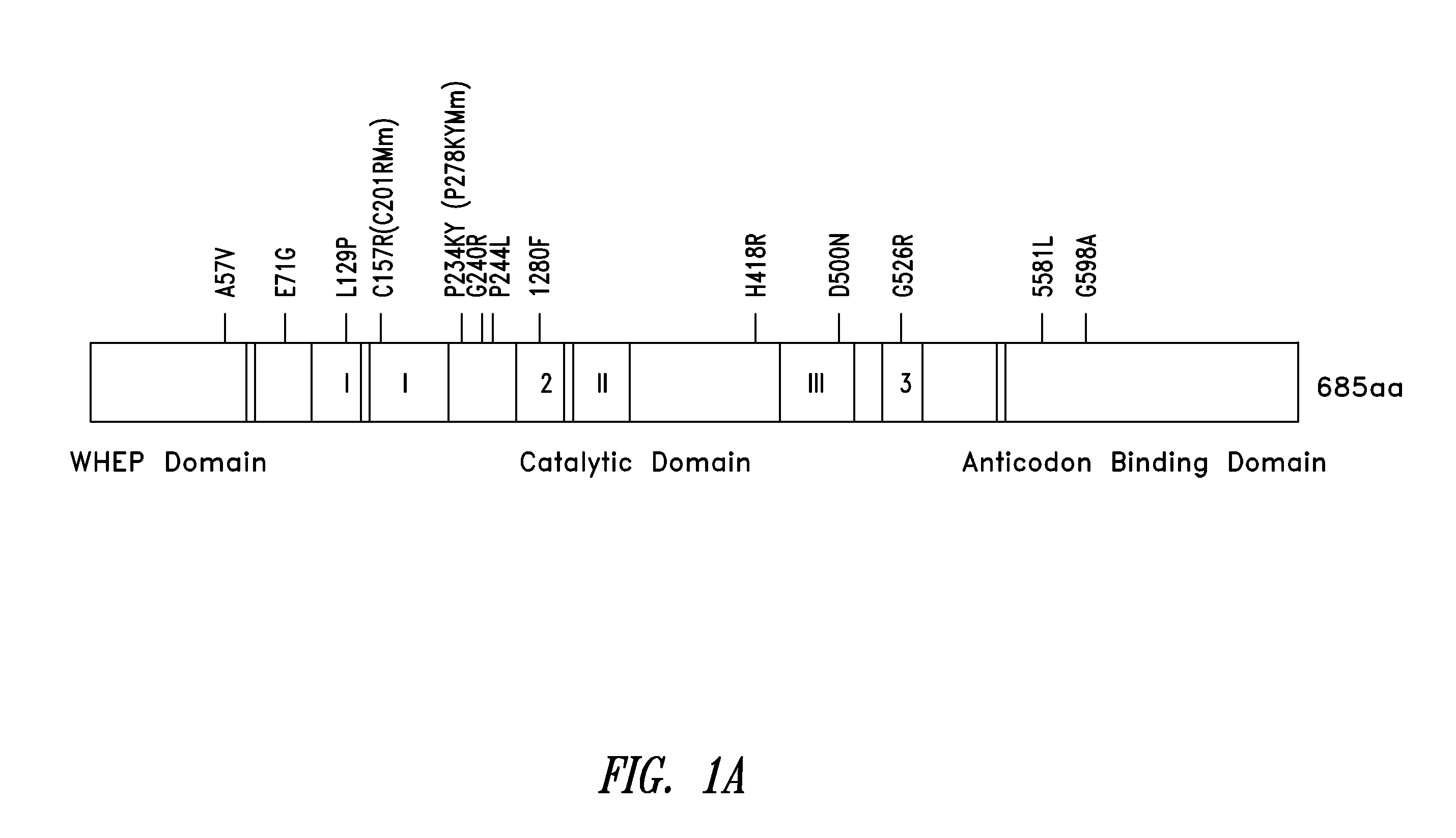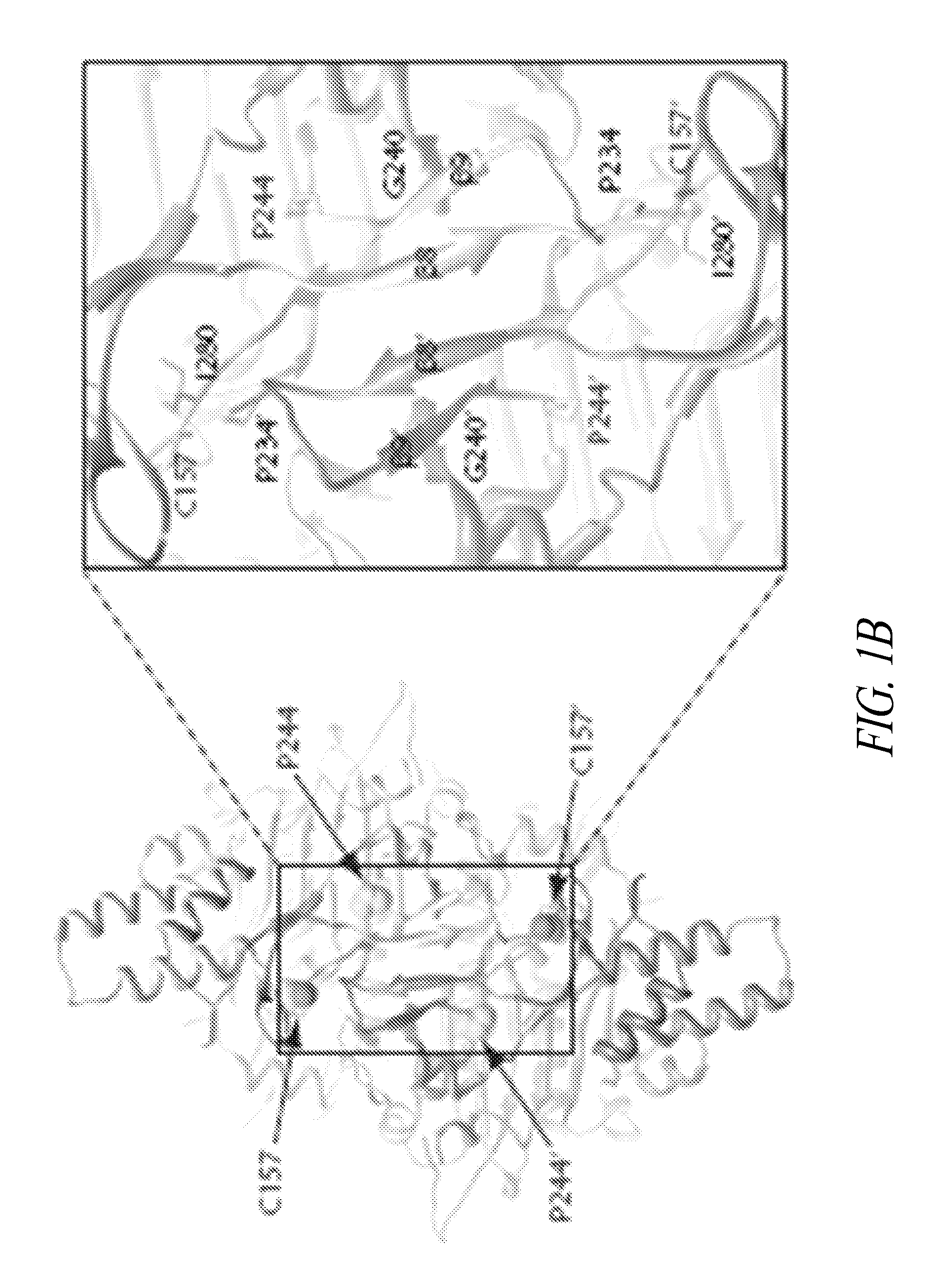Compositions and methods for treating charcot-marie-tooth diseases and related neuronal diseases
a neuronal disease and charcotmarietooth technology, applied in the field of compositions and methods for treating charcotmarietooth diseases and related neuronal diseases, can solve the problems of lack of sequence coverage and lack of common peptides for direct comparison, and achieve the effect of increasing solvent exposur
- Summary
- Abstract
- Description
- Claims
- Application Information
AI Technical Summary
Benefits of technology
Problems solved by technology
Method used
Image
Examples
example 1
HDX Analysis to Identify Opened-Up Regions in Glycyl-tRNA Synthetases Associated with Charcot-Marie-Tooth (CMT) Disease
[0331]The question of how dispersed mutations in one protein engender the same gain-of-function phenotype was explored. The studies described herein focused on mutations in glycyl-tRNA synthetase (GlyRS) which cause an axonal form of Charcot-Marie-Tooth (CMT) diseases, the most common hereditary peripheral neuropathies. Because the disease phenotype is dominant, and not correlated with defects in the role of GlyRS in protein synthesis, the mutant proteins are considered to be gain-of-function neomorphs.
[0332]Given that previous crystal structures showed little conformational difference between dimeric wild-type and CMT-causing mutant GlyRSs, the mutant proteins were investigated in solution by hydrogen-deuterium exchange (monitored by mass spectrometry) and small-angle X-ray scattering to uncover structural changes that could be suppressed by crystal packing interac...
example 2
Two Newly Identified CMT-Associated Residues Localize to the Dimer Interface of Glycyl-tRNA Synthetase
[0362]Of the 13 CMT-linked mutations on GlyRS (from patients and mice) identified so far (see FIG. 1A), two—C201R from ENU-induced mice (corresponding to C157R in the human sequence) and P244L from a Japanese patient—have been recently identified (see, e.g., Abe and Hayasaka, J Hum Genet 54:310-312, 2009; and Achilli, et al., Dis Model Mech 2:359-373, 2009). Further to carrying out the conformational studies in solution, it was determined that the two newly identified CMT-associated residues P244 and C157, like the other 11, were localized near the dimer interface (see FIG. 1B). P244 is located on a hairpin structure (β8-β9) that forms an anti-parallel β-sheet across the dimer interface, and which harbors two other CMT-associated residues G240 and P234 (FIG. 1C). P234 and I280—other CMT-linked residues—have been reported to “kiss” across dimer interface (see Nangle et al., PNAS USA ...
example 3
[0363]CMT-Associated Structure Opening of Glycyl-tRNA Synthetase Mutants can be Regulated by the WHEP Domain
[0364]The metazoan-specific WHEP domain is dispensable for aminoacylation (Xie et al., supra). Because the CMT phenotype is not correlated with the aminoacylation activity of GlyRS, and because it was shown that the conformation of the WHEP domain appears primarily affected by one of the CMT mutations G526R (see FIG. 4C), it is possible that the WHEP domain plays a role in a CMT-associated mechanism and is involved in the structural opening induced by CMT mutations. The conformational consequence of removing the WHEP domain was therefore investigated.
[0365]According to the experiments described in Example 1, HDX MS analysis showed that the deletion of WHEP domain largely opens up GlyRS with average increase in deuterium uptake after 1 h exchange of 26% (see Table 1 and FIG. 6F). This level of increase is comparable with that of the CMT-causing mutants tested. Furthermore, the ...
PUM
| Property | Measurement | Unit |
|---|---|---|
| wavelength | aaaaa | aaaaa |
| wavelength | aaaaa | aaaaa |
| dissociation constant | aaaaa | aaaaa |
Abstract
Description
Claims
Application Information
 Login to View More
Login to View More - R&D
- Intellectual Property
- Life Sciences
- Materials
- Tech Scout
- Unparalleled Data Quality
- Higher Quality Content
- 60% Fewer Hallucinations
Browse by: Latest US Patents, China's latest patents, Technical Efficacy Thesaurus, Application Domain, Technology Topic, Popular Technical Reports.
© 2025 PatSnap. All rights reserved.Legal|Privacy policy|Modern Slavery Act Transparency Statement|Sitemap|About US| Contact US: help@patsnap.com



